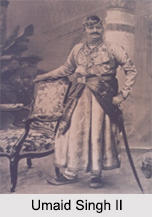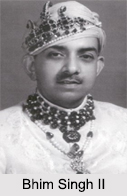 During British rule in India (which covers both the British East India Company rule and later the British Raj), the princely state of Kotah was ruled by different people. These people had served the state as "Maharaos". Given below are the Maharaos of Kotah.
During British rule in India (which covers both the British East India Company rule and later the British Raj), the princely state of Kotah was ruled by different people. These people had served the state as "Maharaos". Given below are the Maharaos of Kotah.
Chhatar Sal Singh I
Chhatar Sal Singh I was the Maharao of Kotah from 1757 to 1764.
Guman Singh
Guman Singh was the Maharao of Kotah from 1764 to 1771. He is known to provide supplies and men to Colonel Monson in his encounter with the Holkar ruler. He is remembered as the first Rajput ruler to conclude a treaty with the British which occurred in 1817.
Umaid Singh I
Umaid Singh I served as the Maharao of Kotah from 1771 to 1819.
Kishor Singh II
Kishor Singh II served as the Maharao of Kotah from 1819 to 1828.
Ram Singh II
 Ram Singh II was the Maharao of Kotah from 1828 to 1866.
Ram Singh II was the Maharao of Kotah from 1828 to 1866.
Shatrushal Singh II
Shatrushal Singh II served as the Maharao of Kotah from 1866 to 1889. Singh II"s reign coincided with misrule and oppression which resulted in the administration of the state being taken over by the British Government in 1874 and handed over to the Political Agent and a Council of Regency.
Umaid Singh II
Umaid Singh II served as the Maharao of Kotah from 1889 to 1940. On 11th of June, 1889 Umaid Singh II succeeded as the Maharao of Kotah by adoption. He attained complete powers of a ruler on 5th of December, 1896. During his rule, the state prospered till the occurrence of the late famine of 1900. This famine resulted in a temporary depletion of the states finances. Careful management recuperated the state from the effects of the famine.
Bhim Singh II
Bhim Singh II served as the Maharao of Kotah from 1940 to 1947. He had held many titles like that of being a Honorary Brigadier in the Indian Army, Honorary Colonal of the 17 Poona Horse, India`s alternate delegate to the United Nations General Assembly in 1956 and President of the Rajasthan State Board of Wildlife. For various purposes, Bhim Singh II had made donations, for example, a donation of Rs 700,000 for the construction of a general hospital in Kota, which is known as `Maharao Bhim Singh General Hospital.` He had represented India in shooting championships.



















